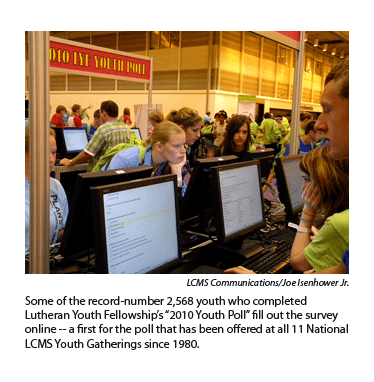By Linda C. Hoops
About 80 percent of the youth who took part in the Lutheran Youth Fellowship Youth Poll at this summer’s National LCMS Youth Gathering have either an “excellent or good relationship with their parents,” ac cording to the poll results. Nearly 78 percent live with both natural parents, 18 percentage points higher than the national average.
cording to the poll results. Nearly 78 percent live with both natural parents, 18 percentage points higher than the national average.
These are two of the bright spots of the poll that has been taken at all 11 of the National LCMS Youth Gatherings since 1980. It is sponsored by Lutheran Youth Fellowship, the Synod’s national youth organization.
For the first time, this year’s poll was entirely online. With 2,568 youth and 331 adults responding to the questions, the participation rate was the highest it’s been during the past 30 years and exceeded the 10 percent ratio (which is considered a solid sampling size) of all Gathering attendees (24,000).
For the 2010 poll, 35.4 percent of the youth were males and 64.6 percent females. By age, 14 percent were 14 years old, 24.8 percent were 15, 25 percent 16, 19.7 percent 17, 13.2 percent 18, and 3.2 percent were 19.
“When one looks at the data collected in the poll, there are some things that are encouraging, some things that are kind of funny or quirky and some things that put our teenagers right in the middle of the way our society and culture are trending,” said Dr. Terry Dittmer, director of LCMS Youth Ministry.
“Our youth, like most of the world these days, don’t seem overly connected to the concept of absolute truth. We have a responsibility to boldly confess and teach what we believe and at the same time be welcoming and supportive of our youth as they find their way toward adulthood.”
Dittmer noted that the data not only reflects the thoughts of Gathering participants but probably also those of most active youth in an LCMS congregation. “It is important to remember that not all the data is going to be ‘good news’ and that it is reported here because this is what participants told about themselves.”
On where they go to school, 77.5 percent attend public high school which compares to 61 percent in 2007. Almost 10 percent attend a Lutheran high school and another 5.4 percent attend a private or parochial high school. There also was a slight increase in those who are being home-schooled: 2.4 percent compared with 1.5 percent in 2007.
Concerning church participation, almost three-quarters (74.3 percent) of the young people identify themselves as active or very active in their congregation.
Yet, in response to the statement, “I rely on God to help me make decisions,” only 21.8 percent said always, while 70.4 percent said sometimes. The highest “always” response to this question came from 14-year-olds (28.9 percent) and may relate to their recent confirmation experience, according to Dittmer.
On engaging in personal Bible study or devotion, “very little/almost none” was the response of 42 percent, a figure largely unchanged during the past 30 years of the poll. About 5 percent said they did more than two hours per week and 43.6 percent said 15-60 minutes per week.
In asking about their connection to God, 56.3 percent said they may have some questions but felt good about God and 35 percent said they feel very close to Him.
Social Issues
On questions of social issues, including sexuality, drugs and alcohol, abortion, the death penalty and global warming, Dittmer said LCMS youth seem to be trending in the direction of the general population in responding to the questions:
* 53 percent took the moral position that premarital sex is always wrong, down from 58.4 percent in 2007 and from 63.3 percent in 2004; but up from 47.5 percent in 1992 and 43.6 percent in 1986.
* 67.3 percent claimed to never have engaged in sexual intercourse. Dittmer noted that there is the trend present among LCMS youth that as they age, they engage in more sex, starting with 3.1 percent of 14-year-olds and ending with 17.1 percent of 19-year-olds.
* 59.7 percent said homosexuality is always wrong, down from 65.8 percent in 2007 and 70 percent in 2004. Among males, 69.7 percent said homosexuality is always wrong, compared with 54.2 percent of females, a 15-point difference. Just over 31 percent said homosexual behavior is “their business and nobody has the right to tell them it’s a sin.” LCMS youth “seem to definitely be trending with society as a whole towards acceptance” on homosexuality, Dittmer noted.
* Only 53.2 percent said marriage is for one man and one woman, compared to 57 percent in 2007 and 70.5 percent in 2004. Gay marriage was approved by 18.5 percent and another 11.5 percent favored civil unions.
“One thing cited as to why the support for gays and lesbians has increased in the general population is simply that most young adults these days say they have a ‘gay friend’ and they don’t want to be judgmental,” Dittmer commented.
Concerning addictive-substance usage, 88.9 percent indicated they don’t smoke and 90.4 percent said that they never use drugs. The youth who said they never drink alcohol rose from 44.6 percent in 2007 to 65.8 percent, although 19.8 percent said they have been drunk at least once in the past 12 months.
“This number is down from the 24.6 percent [who said they had been drunk at least once] in 2007,” Dittmer noted. “Still one out of five youth is something to be concerned about.”
With life concerns, 72.9 percent of youth say abortion is always wrong, and 38 percent say they favor the death penalty.
Only 30.5 percent of youth think global warming is an issue to be taken seriously, down from 42.8 percent in 2007 when the question was first asked. “It’s not a real problem” went from 12.5 percent in 2007 to 22.6 percent in 2010, with 89 percent saying their families recycle at least “sometimes.”
Matters of worship
* 31.2 percent of Gathering youth came from congregations that only offer traditional worship, 3.8 percent came from churches offering only “contemporary” worship, 50.9 percent from churches offering both traditional and contemporary services and 8.4 percent offering blended services.
* 15.8 percent of all youth said they prefer a variety in worship; 28.9 percent prefer contemporary; 33.1 percent prefer a mixture of old and new “not necessarily from a hymnal”; and 22.2 percent indicated they prefer traditional, liturgical worship. Male youth (28.4 percent) expressed the strongest support for traditional, liturgical worship.
* 61.5 percent said their churches use Lutheran Service Book, which compares with 48.7 percent in 2007.
* 33 percent said they can recite the words to the Common Doxology (compared with 39.9 percent in 2007, 42.6 percent in 2004 and 48.7 percent in 1998); 28.4 percent said they can’t recite the doxology and 38.6 percent checked “What’s the Common Doxology?”
* 70.7 percent of youth have been on a Servant Event or mission trip.
* 6.4 percent of youth are planning to go into a church career, while 26.7 percent said they would consider a church career but had made no career choice. Another 27.2 percent said they had never really thought about it.
“In terms of recruitment, there would seem to be a large pool of Gathering youth who could be interested in becoming the next generation of pastors, teachers, DCEs, deaconesses and others,” said Dittmer.
Concerning ecumenical matters, 19.5 indicated they think all religions are pretty much alike and 54.1 percent think all Christians should be able to worship together.
Only 45.2 percent of poll participants said that they agree with the LCMS position on women’s ordination, with 22.8 percent calling for more study, and 12.2 percent supporting women’s ordination.
The final question on the survey asked participants to identify their top three concerns from a list of 26 issues. While the top concern for youth was “college” at 30.8 percent, the second top concern was “my own faith” at 29.1 percent, followed by the future (28.5 percent), friends (23.5 percent) and abortion (17.4 percent).
“My own faith” was number one in 2007 at 28 percent and in 2004 at 30 percent.
“Any number of studies about youth spirituality seems to show the fragility of teenage faith, at times, strong and bold and, at other times, threatened and timid,” Dittmer said. “Teenagers at the National Youth Gathering find it easy to express their love for God and Jesus Christ in the company of believers. But these figures almost seem to suggest that, as connected as they are at the Gathering, when they get back home to their friends, families, schools and jobs, that same faith connection could easily fall apart. For youth workers, lay and professional, this concern needs to be taken seriously. Adults need to model the faith and care for and support the young people in their charge. There is so much besieging their faith, they need our bold confession.”
The statistical data for all questions, including figures for the total youth population, youth by gender, youth by age, total adult and adult by gender is available online at the LCMS Youth Ministry website at www.lcms.org/?1806.
Linda C. Hoops is a freelance writer and member of Lutheran Church of the Resurrection, Sunset Hills, Mo.
Posted Oct. 6, 2010




